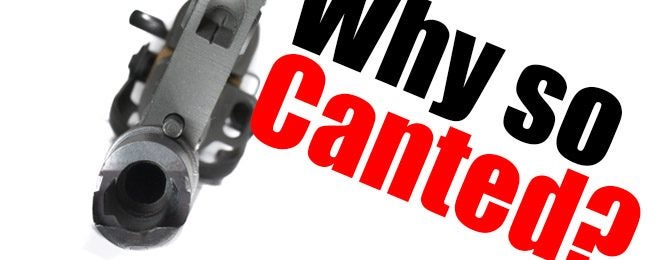While writing an article on available muzzle brakes and compensators for Kalashnikovs, I found myself at an impasse. Despite shooting and customizing AKs for more than a decade, I never really dug into the reasons behind the angle of the iconic slant brake. I was stuck wondering why the AKM’s muzzle brake canted?
Ready to follow me down the rabbit hole of Soviet weapons engineering?
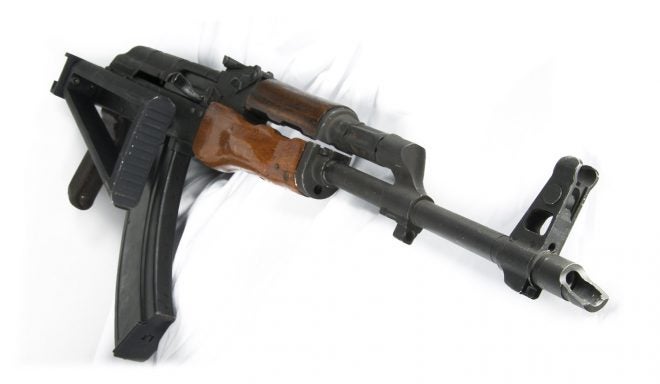
A post-ban Romanian SAR AKM with welded-on slant comp, early slab-side magazine, and Manticore Arms side-folding triangular stock.
Muzzle Brake or Compensator?
First off, the iconic slant brake is in fact not a brake at all, but a compensator. A muzzle brake by definition diverts some escaping gas and ejecta from the muzzle rearward. By propelling it towards the shooter, brakes directly counter the linear recoil impulse.
A compensator, on the other hand, diverts excess gas to counter muzzle climb. So not necessarily reducing recoil, so much as keeping the muzzle on target. This is arguably a matter of semantics since both are designed to get rounds on target faster – but the difference between them is still important.
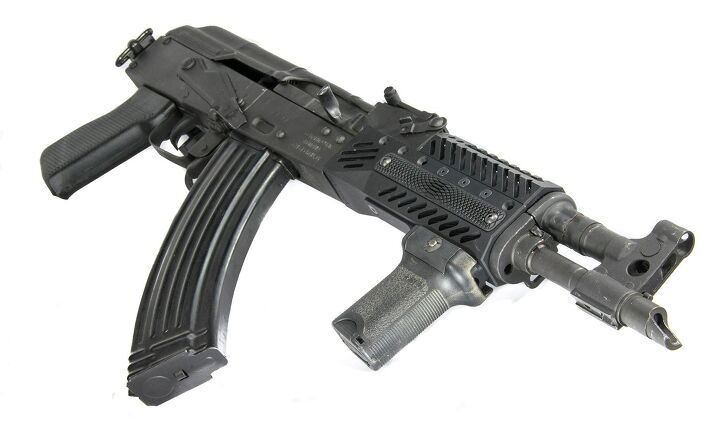
This custom Romanian Draco SBR still rocks the Mil-Spec compensator, despite better options being available.
For the most part, brakes put the brakes (see what I did there?) on a rifle’s rearward movement. This makes them great for large caliber firearms, or those with exceptional amounts of energy/recoil. This is why big bore blasters like Barrett’s 50 calibers autoloaders include the massive 12-ounce brake on the business end. There’s not much point to reducing muzzle climb if the gun’s recoil impulse pushes the shooter off target every shot.
When to Use Each
Conversely, putting a gigantic brake on a .22 Magnum pistol is equally pointless; there’s not enough energy to merit an aggressive brake. Plus, brakes tend to exaggerate muzzle blast by diverting it towards the shooter’s face. So pairing a tank-style brake and a barrel too short to fully burn all the powder of a particularly blasty cartridge like .22 Magnum results in a poor man’s Dragon’s Breath – effectively blinding and deafening the shooter.
Compensators are better employed on lightweight, semi or fully-automatic firearms that are difficult to control during rapid, or automatic fire. In a nutshell, any firearm that suffers from excessive muzzle climb benefits from the addition of a comp. A notable exception being non-fixed barrel handguns. The change in cycle speed affects reliability in a similar way to adding a suppressor without a booster.
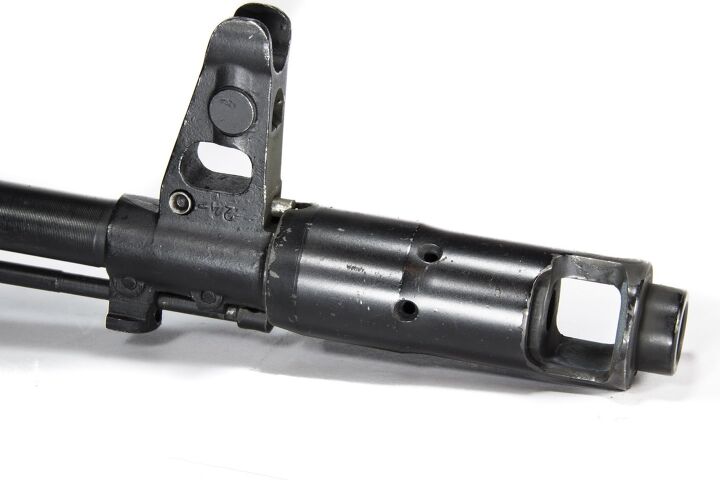
Modern Kalashnikov rifles like this AK-100 series clone, utilize an aggressive brake.
But we’re diverting from the original question – why is the AKM’s muzzle device canted to the right?
In a nutshell, it’s angled roughly 22 degrees off-center because the AKM designed for fully-automatic fire from right-handed shooters.
Let me explain.
Ergonomics of Automatic Fire
When properly firing a shoulder-fired weapon, shooters have to pick a shoulder to anchor the weapon’s stock. Their shoulder acts as a recoil buffer, and counter to rearward recoil impulse. The support hand, however, either does nothing but support the weight of the gun in the hands of a target shooter, or counters muzzle rise/drift in during rapid shooting like 3-gun matches or firefights.
When the recoil impulse travels down the rifle and into the shooter, it causes the gun to pivot up and away from the shooter’s support shoulder. The horizontal direction depends on the shooter’s dominant hand. Since the overwhelming majority of people in the world are right-handed, Soviet engineers implemented a compensator that is most effective for them.
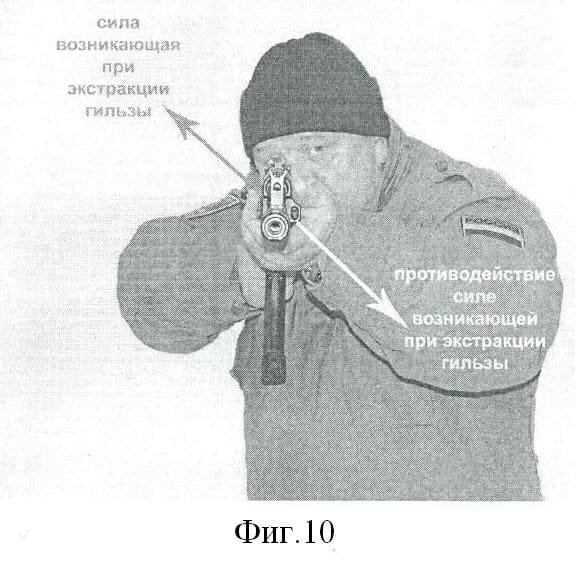
“Force created by spent shell extraction”. AKA Recoil.
Sorry Southpaws
This isn’t surprising, given how Soviet doctrine at the time painted left-handed people as defective. There was even propaganda painting left-handed people as more likely to be thieves and mentally ill. [Arendt H. “The Origins of Totalitarianism”] Which is obviously ludicrous.
Soviet southpaw shooters were forced to use their non-dominant hand. This includes shooting right hand only. But in this rare instance, it was to their benefit. Given the angle that the AK’s slant comp deflects escaping gas, it pushes the muzzle, and thus the handguard back down and into the supporting left hand.
Shooters attempting to fire an AK with this comp left-handed are in for a nasty surprise. The comp will actually work against them, and violently the muzzle away from their support hand. This makes for an extraordinarily awkward recoil impulse, and a difficult gun to control.
Interestingly, the slant comp seems specifically tuned for 7.62x39mm’s recoil impulse and the angle of an AKM’s stock. At least this has been the case in my personal experience firing Zastava NPAP-pattern rifles in 7.62x39mm, and both Romanian WASR and Chinese Norinco AK-clones in other calibers like 5.45mm and 5.56mm equipped with the slanted comp.
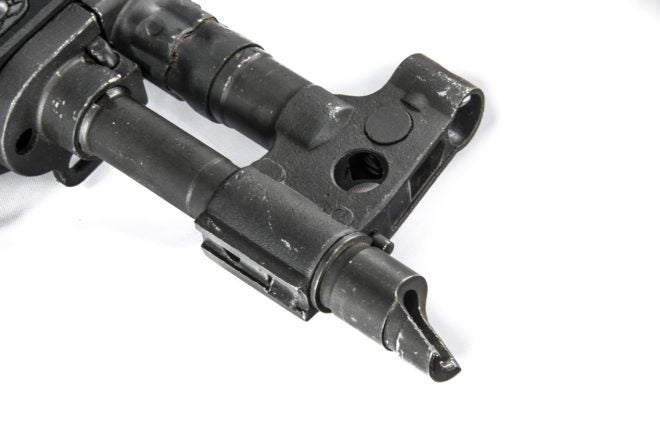
Close up shot of this well-loved Draco SBR’s slant compensator.
Compensating?
In testing, these guns are clearly overcompensated. The excess blast causes the stock to hit the shooter’s chin with unsettling authority. This is part of the issue behind the NPAP’s notorious chin-slap problems. Unfortunately, the problem persists when running either an M4 stock with adapter or Magpul’s Zhukov furniture with the slant comp.
However, the sort of shooter likely to put either of these on their AK is just as likely to swap out the muzzle device for something more modern. And make no mistake, there are better options on the market – but I’ll save my musings on the topic for another article.
Suffice to say, despite some of the craziest theories I’ve ever read on the subject (One poster believed it was to counter the bullet’s torque!), the real reasons are far more mundane.
 Your Privacy Choices
Your Privacy Choices
